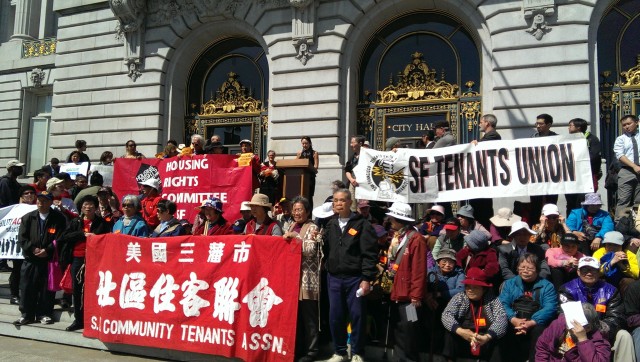Kim’s eviction regulations will infuriate the big landlord lobby — but they could be good news for the local economy

By Tim Redmond
MARCH 13, 2015 – The new package of tenant measures introduced by Sup. Jane Kim will force another showdown at City Hall, with progressives and tenant activists working to defeat the almost certain opposition from landlords – and like the David Campos Mission Moratorium, will force the supervisors to take a side.
And if Kim can get six votes, it will be exceptionally difficult for the mayor to veto an anti-eviction package in 2015.
The bills, which are still being finalized by the City Attorney’s Office, contain a powerful new element that might turn out to be a way around the dreaded state legislation that prevents rent controls on vacant apartments.
In certain circumstances – say, owner-move-in evictions, or evictions due to major capital improvements – future rents would be capped at the existing level. That would mean a landlord couldn’t evict tenants, renovate the place, and rent to new tenants at higher prices (even if the old tenants decided not to return).
That would take a lot of the economic incentive out of some types of evictions. There are numerous cases where landlords claim to move themselves or a relative into a unit that’s been occupied for years under rent control, then after a few months or a year, move that person out again and re-rent the place at a higher price.
And in some cases, renovations take so long that the tenants – who have the right to return at their old rents – give up and move somewhere else.
State law bars cities from imposing sweeping rent controls on vacant apartments. That’s eliminated one of the most effective tools for providing long-term affordable housing in California communities.
Vacancy control, which used to exist in Berkeley and Santa Monica, is Landlord Enemy Number One, and over the decades, landlord groups have used political pressure, lawsuits that reached all the way to the US Supreme Court, and eventually state legislation, to get rid of it.
This would only be a tiny element of that, but I suspect it will raise the same type of landlord ire.
While that may be the most politically challenging part of the package, it would affect only a relatively small number of apartments. The limits on what tenants call “low-fault” evictions could have a much greater impact.
The legislation, cosponsored by Sups. David Campos and Eric Mar, would give tenants time to fix the relatively mild transgressions (like hanging out laundry) before an eviction notice can be filed.
That could slow or halt hundreds of potential evictions in the city.
The new set of laws is being introduced just as a new study suggests that high rents, which take money out of the pockets of consumers and often communities and send it to wealthy landlords, is hurting economic growth in San Francisco.
That’s pretty logical: Tenants, who tend, on the whole, to be less rich than landlords, are more likely to spend extra month in their pockets. That helps create jobs at community businesses.
And small community businesses are far more likely to hire people who come from the neighborhood and don’t have advanced degrees in computer science. That’s a different kind of job growth than Mayor Lee has been promoting – but it’s at least as important as tech jobs.
There are some small landlords in San Francisco who use their rental income to buy food and clothes for their families. There are, as we are always reminded in these debates, some tenants who are quite well off.
But economists have to look at aggregate data, and Enrico Moretti and Chang-Tai Hsieh say that overall, high rents correlate to concentrated wealth which isn’t good for local economies.
Their proposed solutions are typical of what Moretti tends to suggest: Tear down all the Victorians and turn all of the city’s neighborhoods into the density of midtown Manhattan. Build a few hundred thousand more units of housing and maybe rents will come down.
How all of those people will get around in a city that already has problems with its transportation system, and where they will send their kids to school, and how many of them will fit in Dolores Park, are not questions the likes of Moretti tend to answer.
Nor do they ask whether San Franciscans want to live in midtown Manhattan.
(I’m not against density. North Beach is an exceptionally dense area, and still livable. I don’t have an interest in living in Manhattan.)
And of course, we all know that there’s little evidence that building more market-rate housing ever brings down rents in San Francisco.
But if we take Moretti’s thesis – that high rents are bad for local business – and address that with tighter regulations on rents and evictions, we can seek the same result.
And we know from years of proven evidence that rent control works, that eviction protections prevent the loss of affordable housing, and that housing with price-limits attached keeps working-class and low-income people in the city.
I wonder if Sup. Scott Wiener will demand that the city economist do a study of Kim’s legislation – and if so, whether Ted Egan will look at how rent regulation benefits the business climate. We’ll see.



